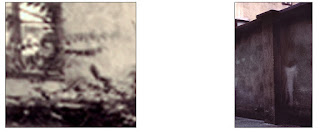Camera Obscura is dedicated to Dave Heath and Jim Borcoman
Post #2
(cursor on photograph, for detailed viewing)
The Snapshot, History Painting and A Storyteller, Waiting for Words
Tears for an Empty Desert
Double-page layout edited to adjust for blog.
2006, Michael Schreier
As the Old Sing, So the Young Pipe. 1640 Family Portrait
Jacob Jordaens, circa 1985
National Gallery of Canada Michael Schreier
I am most appreciative to the National Gallery of Canada for its clear and informative essay concerning Jacob Jordaen's painting As the Old Sing, So the Young Pipe, 1640. Essay/History to Jordaen's As The Old Sing.
However, allow me to digress for a moment and return to my father's portrait from the previous posting:
Portrait of my father,
circa 1985
Michael Schreier, From artist's book Tears for an Empty Desert, 2006
Prior to his death, and for several years, my father referenced Austria's daily journals; prompted perhaps by an increasing anxiety for his decision to sever all ties with his European roots, he came to realize that returning would be impossible. My father expressed serious difficulty with this portrait, as it may have highlighted an uneasiness, that his privileged musings could be so readily recognized. His accidental death in 2005 suggested a deeper unresolved ambiguity: my response would be the threnody,
Tears for an Empty Desert, 2006.
Gaile McGregor's The Wacousta Syndrome: Explorations in the Canadian Langscape, associated with James Fenimore Cooper's iconic The Leatherstocking Tales, explores this unique aspect of Canadian identity. Although focused on the routine pragmatics of daily life in one's adopted culture one might still experience a memory of and yearning for one's homeland. She suggests this metaphor of loss as an intrinsic element within the Canadian cultural profile.
Note: the word Langscape is McGregor's, delineating vision as a product of language and voice.
( Page layout, one year after my father's death,
included in Tears for an Empty Desert.)
2006
Collection of the Artist, Michael Schreier.
Further, as my father's death would mark our familial tragedy, its circumstance would reflect a more critical absurdity an embrace for the unknown.
Remember
2006
( Portrait of my mother, one year after my father's death,
included in Tears for an Empty Desert.)
Collection of the Artist, Michael Schreier.
Drawing, circa 1983, included in Shaman's Witness, 2008
Hilde Schreier
As suggested, a memory, a photograph or work of art may offer a portal to thought. I first viewed Jordaens' master work at the National Gallery of Canada in 1968. At the time, I was very interested in theater, having the previous year in high school, with deep conviction and premature hubris, directed Eugene Ionesco's The Bald Soprano. A master of the theater of the absurd, Ionesco touches the very core separating the frailty of memory from storytelling. I have discovered that Jordaens' work interrogates similar notions and I would over the course of my career, when accessible, return to this painting as it continues to enlighten current interests and direction.
( Considering another of Ionesco's plays )
Page Layout from Shaman's Witness, the 2nd in the trilogy:
-Tears for an Empty Desert
-Shaman's Witness
-Storyteller/Waiting for Words
Michael Schreier, Artist's Book circa 2005-9,
(paintings and drawings, Hilde Schreier,
photographs, Michael Schreier)
From Series: A Warm Smile is an Attribute of Charm,
1973, Michael Schreier
(Cyanotype)
Collection: National Gallery of Canada
Remote
2013
From work-in-progress series, (working title; The Differend)
Collection of the Artist, Michael Schreier
True absurdity, I propose, renders elements of both tenderness and empathy. A reverence for humanity's mystery might suggest that the story told, reflects an ethic to be revealed. Would the snapshot simply offer a confirmation, without any judgement or alternative rationale? Or might one consider it less than casual? The snapshot of that prodigious moment requires both a motive and then directive. Yet the artist may employ this common style, engaging with a more comprehensive dialectic, while framed within the rubric one of numerous "to witness". Eric Fischl's Krefeld Project touches on chords of melancholy, sadness, and humor, with little contemporary cynicism, embracing complex thoughts for loss and bewilderment, a truly masterful work. His work underscores the very nature of contemporary history painting and storytelling and can be referenced with Paula Rego's Pillowman and Balthus and the Cardgame.
Conversation/Pause,
2015
From work-in-progress series, (working title; The Differend)
Collection of the Artist, Michael Schreier
It is during moments of doubt, while still embracing with the quotidian, that I allow myself a respite in reverie a reflective silence a nurturing of a sense of place. The snapshot, I suggest, is always linked with storytelling, offering each of us a window to continuity and a mirror for the self. Finally Jean-François Lyotard's The Differend: Phrases in Dispute suggests a unique perspective; consider an interim both a tie to and separation from immediacy in which a generated pause is exiled from continuity and rational thought.
Gyorgy Kurtag's remarkable composition resonates to voice, silence and the orchestration of space.
Family Moment
2015
From series, (working title; The Differend)
Collection of the Artist, Michael Schreier
Diptych: From series Portraits in Silence, 2003,
Collection of the Artist, Michael Schreier
16..04..03, 13..45..15 16..04..03, 13..40..11
(#s metadata timeline for photograph: day..month..year..hour..minute..second)
(note the order for the placement of the photographs in the diptych: the time line clearly indicates that the photograph on the right was taken first. What might this artist's intentional reversal imply?
A blog traditionally offers chronologically connected observations with historical references: it can also become an independent voice playing with associated imagery and thought. This blog is of the latter, not attempting to categorize logic with existing rationale but to offer an exploration for both unity and chaos.
This blog may be its own Storyteller/Waiting for Words
Disappearing Numbers
from exhibition,
Storyteller/ Waiting for Words, 2009
Ottawa Art Gallery, Curator, Emily Falvey
Collection of the artist, Michael Schreier
( Cursor images for detailed viewing.)
Post #3
The Constructed Image/Directorial Mode and the Sequence
February 7, 2016
























